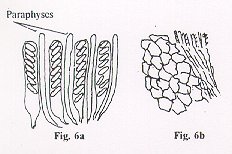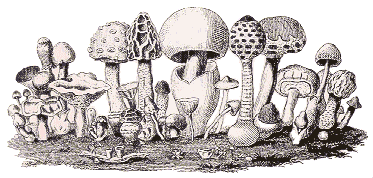The term Ascomycete or Asco for short is often mentioned during fungal forays. To the more knowledgeable the term is fairly well understood, but to the uninitiated it probably sounds like some secret code.
Ascomycetes are not in the main intentionally sought out, the majority of species being more or less microfungi although there are a number of Ascos which are reasonably large eg. the Peziza group. But, in general, their small size or their niche habitat make them easily overlooked and therefore they are very much under recorded. Nevertheless Ascos are a very fascinating group. Their structures and life style are just as interesting as the larger fungi.
For those who might be wondering what makes an Ascomycete then, to put it simply, it’s in the design of the spore-bearing structure. You will be familiar with the larger gilled fungi (Agarics) known as Basidiomycetes. These species have spore-bearing structures known as basidia. But for the Ascomycetes the spore-bearing structure is known as an ascus. This structure represents a kind of elongated ‘sac’ in which the spores (usually eight) are formed.
There are currently some 46 orders covering 264 families which equates to approximately 32.267 species in the Ascomycotina (Hawksworth et al 1995) of which approximately 10 orders would probably cover the most common species. The remainder are more difficult to find and probably only a specialist would search them out, otherwise they might only be found quite by chance during forays.
Broadly speaking, an example of a commonly observed Ascomycete would be Xylaria hypoxylon, the Candle-Snuff or Stags Horn Fungus. This wood decomposer can be quite a striking fungus with its antler shaped fruiting body. Xylaria is a member of the Xylariales order which used to be known as the Sphaeriales order (Hawksworth et al 1995). The fruiting bodies of this order are known as perithecioid stromata (a mass of vegetative hyphae in which the spore-bearing structures are produced) Other species commonly found in this order are Xylaria polymorpha, Dead Mans Fingers, and of course Daldinia concentrica, Cramp balls.
But amongst the more widely observed and recorded of the Ascomycetes are the Discomycetes. These are the more delicate species, some with quite striking colours. This group belong to the old order Helotiales. Again, to keep you up to date, the order is now referred to as Leotiales. The fruiting body of this order is known as an apothecium. The term Discomycete is a loosely descriptive word which refers to species that are more or less saucer or cup shaped with the hymenium (the spore bearing layer) lining the inside of the fruiting body. They range from minute species, Saccobolus, to the larger Morels (Morchella) and can be stipitate (stalked) or sessile (having no stalk).
We have mentioned two types of fruiting body, the perithecoid (order Xylariales) and the apothecoid (order Leotiales); now let us examine them in turn and try to understand a little about their spore dispersal technique.

Perithecioid: this means flask shaped. A good example is Xylaria polymorpha, Dead Mans Fingers (fig 1). From the diagram you can see that the fruit body or stroma is stipitate, fairly broad and cylindrical. If we cross-section the stroma (Fig 2) the various components of the fungi are revealed.

The bulk of the body is made up of tightly compacted vegetative hyphae, loosely termed the flesh. At the outside of the flesh are the spore chambers, these being the perithecia, or flasks, within which the asci and ascospores are formed, separated by sterile hyphal elements called paraphyses. Finally the whole body is encased in dark hyphal tissue, which is covered by minute openings known as ostioles (fig 3) through which the spores are discharged. Because the ascus and spores are encased within the perithecium they cannot be discharged simultaneously as they would be in the Discomycetes, but instead as the spores mature. pressure builds inside the perithecium and the asci jostle to reach the ostiole but, because of its narrowness, only one ascus at a time can enter. So, to achieve successful discharge of the spores, the tip of the ascus must protrude beyond the ostiole (fig 4). At this stage, as the pressure continues to build, the tip of the ascus splits apically and the spores are violently discharged beyond the stroma to be carried away by the air currents. Once the pressure is released the empty ascus collapses and drops back into the perithecium thereby allowing the next ascus to start the discharge process all over again.

Apothecioid: cup or saucer - like. These ascomycetes are different in that the hymenium (spore-bearing layer) is open. If we look at one of the more common species which is regularly recorded on our forays - Mollisia cinerea (fig 5) - we will be able to see the difference. Mollisia belongs to the family Dermataceae, species which can be flat or concave, usually sessile and have drab colours - grey or brown. The cross-section (fig 6) shows the cup to be made of vegatative hyphae with the hymenium layer exposed.
The outer layer of the apothecium is a specialised layer known as the excipulum. (fig 6b) This hyphal tissue or textura is a diagnostic feature which is used to distinguish the different types of Ascomycete especially within the Discomycetes. The hymenium itself consists of the asci intermixed with the parallel paraphyses (Fig 6a) These species are phototropic, in other words all the asci point towards the best available light. As already mentioned in the Xylaria, as the spores mature, the pressure begins to build within the hymenium until it reaches a certain pitch at which point all the mature asci burst and the spores are released, the cycle then repeats itself. Spore dispersal is gradual over the whole hymenium and may take several days before the majority of spores have been released.

Other examples of Discomycetes which are commonly recorded but are unusual in that the apothecium is formed on a stout sterile stalk are the Morels, Morchella, and the Helvetias both of which belong to the order Pezizales.
In the the Morels the spore-producing layer is spread over the surface of a number of shallow pits known as alveoli. Thus the hymenium is continuous except for sterile ridges which separate these neighbouring pits. The hymenium remains more or less horizontal and, as already mentioned, because of phototropism the ascus tips will curve towards the light and in doing so the spores are discharged and projected outwards unhindered and so do not clash with the maturing spores from the other alveoli.
In the Helvellas the discharge principle is the same as the Morels, but the hymenium is continuous and formed into a saddle shape on the sterile stipe.
There are of course more complicated forces at work and so these descriptions of the perithecia and apothecia are described in their simplest forms just to give a little insight into their structure and the way these Ascomycetes disperse their spores.
References
Ingold C. T. (1953) Dispersal in Fungi
Webster J. 1(1970) Introduction to Fungi
Hawksworth D.L. et al (1995) Ainsworth & Bisby’s Dictionary of the Fungi, 8th edition
Cannon P. F. et al (1985) The British Ascomycotina, An Annotated Checklist
